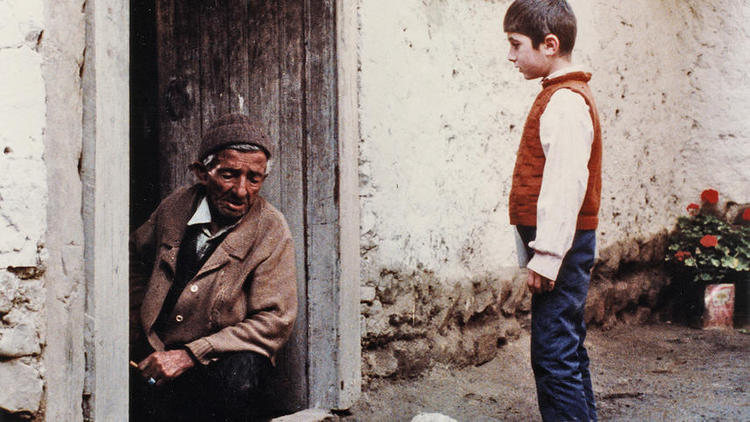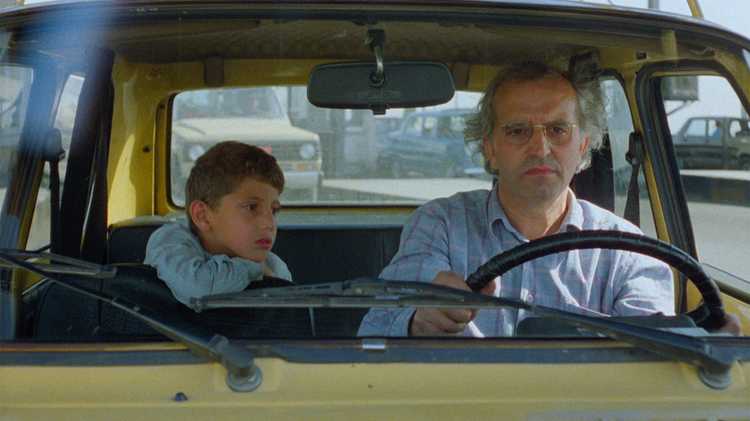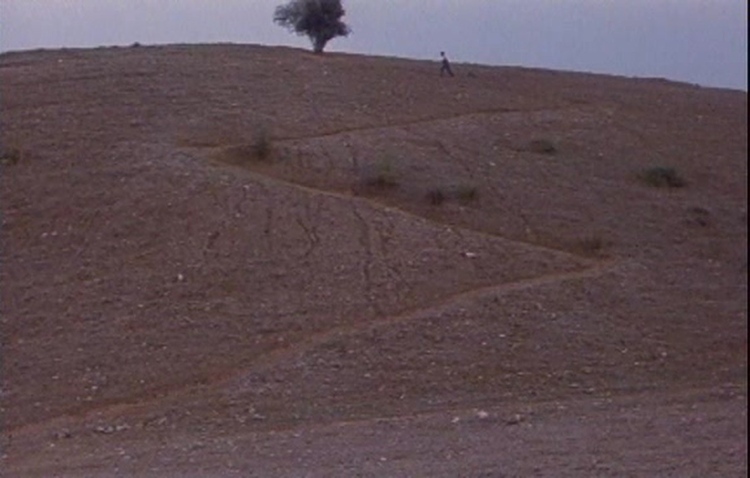Blu-ray Review: Kiarostami's KOKER TRILOGY Envelopes Cinephiles
Criterion's release of Abbas Kiarostami's celebrated trilogy is one of the best sets of recent memory.

Between 1987 and 1994, the late venerated Iranian filmmaker Abbas Kiarostami released three films that would serve not only as personal commentaries on life in his home territory of Koker, but also as examinations of how an artist’s ongoing work can and does relate to the work produced prior. The resulting series, which has come to be known as The Koker Trilogy, has been made available by the Criterion Collection in a breathtaking Blu-ray box set.
Where is the Friend’s House? (1987)
Kiarostami’s village of Koker circa 1987 is a fully tactile place. Rife with dusty, muted colors, mainly beiges and tans with hits of deep greens and dark oranges, the place and its people wear their earthiness with humility and emote the fortitude of generations. Provincial yes, but also tremendously rural; Koker lies within convenient running distance to the next village over. Adults in this film are abnormally fixated on doors- making doors, selling doors, missing doors. The symbolism repeats throughout with keen variation. Could Kiarostami have known that with Where is the Friend’s House?, he’d be unlocking a cinematic pathway that would keep him engaged with these characters and Koker into the next decade, through its own major disaster and his own international success?
Dispatched by the Institute for the Intellectual Development of Children (which he was closely involved) to create a film focusing on kids, Kiarostami set out to explore classroom tensions. The first of this trilogy is the simplest of stories: an extremely rigid teacher is grilling his classroom full of seven-year-old boys about their homework. One particularly fragile boy has finished his on loose-leaf paper as opposed to having done it in the required notebook. In response, the teacher shames him for not using the notebook after being told two other times to do so. He abruptly tears up the assignment, “to teach him a lesson”. The boy then breaks down into a fit of tears that is so affecting it propels the entire rest of the plot. Then, throwing salt in the wound, the teacher informs him that if this happens again, the boy will be expelled.
After school, another boy in the class attempts to show some sympathy to the victimized student. But as a result of this brief interaction, the second boy accidentally ends up with the first boy’s notebook. Realizing this and knowing that the first boy will be expelled the next day for not having done that night’s homework in said notebook, he then spends the rest of the film trying to find where that kid lives so that he may return it to him. Along the way though, virtually every single adult encountered either ignores or dismisses him. The desperation of the child is never taken seriously, certainly not by those who love him and know him best. He runs to the next village over to try to find the friend’s house. It is not easy.
Clocking in well under ninety minutes, Where is the Friend’s House? (Khane-ye doust kodjast?) is a humble, direct, and brief little feature, running ever so simply on several emotional registers. One comes away from it with the increased notion that sometimes the problems of children should absolutely not be dismissed. As for its presentation by Criterion on this Blu-ray, no one would be surprised to know that it is was filmed more than thirty years ago via limited means and not well maintained in the interim. The fact that it looks and sounds so good on this Blu-ray is a testament to the fact that the wait for it has been worth it. No shortage of work has been done on Where is the Friends House? to bring us this disc.
In a one-hour and seven-minute-long Q&A session conducted at the Toronto international film festival in 2015 (housed on this disc as a bonus feature), Kiarostami doesn’t exactly close the door on the central issue raised in this film. The final question is asked by a girl who is deeply moved by the film’s affecting sympathies towards the unheard children of the world. In response, the director, who stated multiple times that he was tired and ready for the session to end, curtly said that, in his experience, “it’s children that don’t listen to adults”. Whether it be the intervening twenty-five years talking, or the fact that his interest had obviously shifted at that point to his 24 Frames project, or perhaps the creeping influence of death which would catch up with him in less than a year, he manages to undercut so much of what works about Where is the Friend’s House?. The Q&A is a disappointing if occasionally informative look into the twilight mindset of Kiarostami.
More relevant to Where is the Friend’s House? is the inclusion of Kiarostami’s film, Homework. Homework (Mashgh-e Shab) is a feature-length documentary made shortly after Where is the Friend’s House?, attempting to get at the problems which the titular concern inflicts upon students and their families. The film is a series of talking-head exchanges with kids and the occasional parent. Kiarostami apparently selected an Iranian school for young boys and set up an interviewing station with a cameraman and a few lights pointed at a chair for his subjects. Kiarostami himself seems unaware of the interrogation-like scenario he’s cultivated. The kids all appear to be various levels of deeply scared, traumatized, and just plain intimidated by the dark room, the hot lights, and this stern director in dark sunglasses asking them questions.
One comes away from Homework rather depressed and concerned about the effects that their school’s educational model has had on these children now that they’ve presumably reached adulthood. (Personally speaking, homework is one of the most futile wastes of time for young students, and a major disruption to quality home life. Just this critic’s bias). The film is no great shakes, which Criterion understood when it relegated this Kiarostami film to “bonus feature” status. That said, it is good to have Homework available on Blu-ray, insofar as we should have as much Kiarostami work as possible available in the best quality.
And Life Goes On (1992)
A few years after Where is the Friends House?, a massive, devastating earthquake hit the region of Iran that houses the village of Koker, as well as several others seen and mentioned in these films. A few years after that, out of dedication to the victims and survivors of said earthquake, Kiarostami made And Life Goes On. Whatever humor that Where is the Friends House? managed to grant is understandably absent this time around. And Life Goes On (Zendegi va digar hich), however, is no heavy slog. Like its trilogy predecessor, it tells a very simple story.
A man, who looks suspiciously like Bruce Dern, but isn’t, and a young boy, probably seven or eight years of age, are riding together in a car. That basically sums up the first third of the film. Although in 1992, when this film came out, the earthquake was probably forefront in the minds of most viewers, the 2020 vision of today’s non-Iranian is likely to render it through the distant fog of time. (“Was there an earthquake in Iran back then…? That much rubble can’t possibly be faked… I’d better look this up.“)
Much of the beginning of the film is simply watching the world pass by out of a car window. Left to right, left to right, left to right… in time, the stubborn search takes them literally off the beaten path and onto the omnisciently viewed zigzagging dirt pathways that would become a Kiarostami visual signature.
As the driver heads into the scene of the recent major earthquake, scores of aid workers and volunteers are seen clearing rubble and attempting to help those in need. (View from the car window is an unbroken master shot of the flurry of activity. Not one body is static as we move passed the desperate scene of crumpled structures and multilayered destruction.
And then, the first obvious bit of Kiarostami’s conceptual onion skinning makes itself apparent. In this movie, the other movie is a movie. Eventually, we learn that the driver is a film director and the boy is of course his son. The “film director“ is actually carrying with him a small French poster of Where is the Friends House?, displaying a large picture of its youthful star. He shows it several villagers along the way, asking if they’ve seen the boy. In this film, this man, not Kiarostami directed Where is the Friends House?. Everyone is familiar with the film, referencing the shoot itself. Some even recall having been in the film as an extra. Now though, the director is just another desperate guy in a car looking for someone. For us, we have the first layer of meta-reality, as reflected in Criterion’s stunning artful packaging, which physically has all three films closing around the previous one.
The disc’s bonus features confirm that the film director is in fact a Kiarostami surrogate, and the entire quest as depicted is in fact a re-created version of a mission that Kiarostami actually undertook following the earthquake. In reality he was indeed compelled to venture into ground zero of the earthquake, the village of Koker, because he had to know if the boys who acted in his previous film, Where is the Friends House?, were okay. (Additional bonus features confirm that they in fact survived, and that Kiarostami caught up with them more than once in the following years. They even turn up as themselves in Through the Olive Trees, revealing their survival).
And Life Goes On is the only disc of the three to house an audio commentary. It is an absolute fantastic one by film critic Jonathan Rosenbaum and film historian Mehrnaz Saeed-Vafa, who together, co-authored a recently re-issued book on Kiarostami. Near the end of the commentary, Rosenbaum confirms that, for him, this is the go-to film of this trilogy. He also makes mention of the fact that Kiarostami himself, whom he knew personally, never considered the Koker Trilogy an official trilogy, per se. They speak of how Kiarostami, though an artist to the end, was never a cinephile. They recall the filmmaker’s observation that what matters isn’t whether any given film is ‘true’ or ‘untrue’, but whether it’s a good film or a bad film. From Kiarostami’s perspective, all films are ultimately untrue, even documentaries. The number of anecdotes and expert observations in this commentary bring great depth and awareness to not just this film, and not even just this trilogy, but the entirety of Abbas Kiarostami’s filmography. In addition to this, there’s also a 20-minute extra feature with film scholar Hamid Naficy, who further contextualizes the entirety of the director’s career. It too is well worth its inclusion.
Unfortunately, print damage is evident throughout, particularly on the right of frame. A thin strip of discoloration and weird deterioration comes and goes, like a chemical scratch on the film. Nevertheless, this is no deal breaker. Even with this relatively unobtrusive imperfection, the meticulous amount of restoration evidenced on these Blu-rays is astounding.
Through the Olive Trees (1994)
In the middle of And Life Goes On, there’s a great little scene where the director (Kheradmand), upon reaching a quake-stricken village, has a brief but extremely memorable exchange with a well-dressed young man named Hossein (Hossein Rezai) who is just looking for a pair of socks. The young man explains to the director that, despite the fact that 65 friends and family members perished in the quake the day before their wedding, they went ahead with their nuptials as planned. Because, life goes on.
With 1994’s Through the Olive Trees (Zire darakhatan zeyton), Kiarostami extends his backward glance yet again, adding yet another lens to his reversed telescope. This time, we come to find out that the film director character of the previous film is in fact just that: a character. Now, there is a new unnamed surrogate director (Mohammad Ali Keshavarz- the only professional actor in the entire trilogy), this one in the act of filming And Life Goes On. The locations are the same, the actors are the same, and the scene is the same. The singular qualifier in that last example (“the scene”) is intentional, as the moment we are privy to filming is in fact the above described moment between the young groom and the director. Between casting woes, backstage drama, and the unprofessional talent threshold of the actors, the filming of this one scene stretches out for many takes over the course of many shooting days.
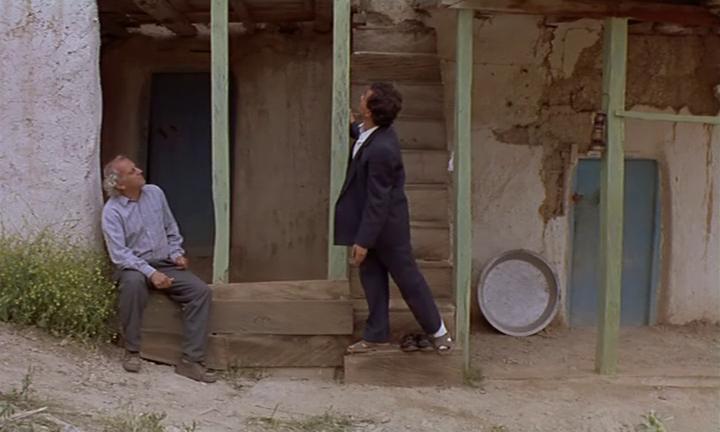
It’s the backstage drama the dominates what little narrative that Through the Olive Trees has to offer. Rezai is heartbreaking as the young man playing the role of the groom. In this film, we discover that though he is illiterate and has no home of his own, he has a big heart and a professed selfless work ethic, none of which we’re given reason to doubt. Thanks in part to a momentary glance at a cemetery, he’s become fixated on the young lady who now happens to be playing the part of his wife. Her part is an off-screen role, enabling her to sit up on the balcony between takes with her nose in a book.
While he waits up there for “action” to be called, he pours his heart out again and again, explaining that from the moment she gave him that glance, he just knew she was the one for him. She, on the other hand, as evidenced by her complete and prolonged silence, feels quite the opposite. As it goes, the second half of Through the Olive Trees is this utterly painful go-nowhere courting process. On one hand, his earnestness and fragile eyes grant him much of our sympathy. But on the other hand, as the scenario stretches on and on and on, one truly begins to wish that this guy could just take a hint.
Kiarostami rather clearly seems to be on the side of the young man, giving him all the close-ups and dialogue. The girl, meanwhile, never looks up from her book. This fruitless strife for connection- for a future- seems to be the underlying point of Through the Olive Trees. In post earthquake Koker, nothing is assured. Hearts must be guarded, lest the scenario mentioned in the repeatedly filmed scene where to play out: They could all die in the next big earthquake. The girl, we are told, was visiting the graves of her earthquake victim parents when she made the mistake of looking up at him. For him, aside from his persistence, his big mistake is fixating too intently upon the future at the likely expense of her need to grapple with the recent tragedy of the past.
Thematically, Through the Olive Trees is undeniably rich. As a film in and of itself however, it’s moderately flimsy. Of the three films included in this so-called Koker Trilogy, this is the one that stands alone the least successfully. Although technically one needs to see the two films that directly envelope it (even as, Criterion’s innovative packaging makes clear, it also envelopes them), much of the richness of the story, if taken out of context, would be reduced to the tale of a poor young non-actor trying to get the girl while making a movie. As compelling as Through the Olive Trees can be in Kiarosami’s, that’s the film’s take-it-or-leave-it ultimatum.
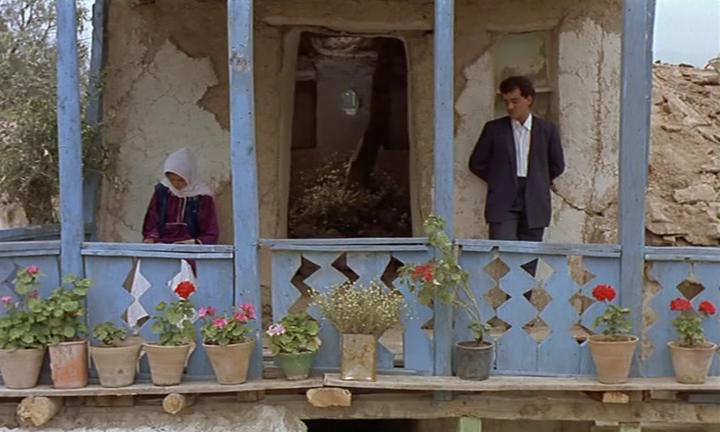
This third and final disc of this set offers as the full extent of its special features two bonus video interviews. Both created in 2018, the first is an informative talk with Ahmad Kiarostami, the filmmaker’s son who’s been managing his father’s legacy since his death. The second is a conversation between Iranian-film scholar Jamsheed Akrami and film critic Godfrey Cheshire (who also authored the long essay that makes up most of the formidable booklet included with the set).
From an A/V standpoint, Through the Olive Trees is the best of the bunch. (Though all three are new 2K restorations) Seeing how the intervening years between Where is the Friends House? and this one saw Kiarostami’s rise as a director of international acclaim at the Cannes Film Festival, it makes sense that the third film would benefit not only in its newness but also due to its significantly heightened prominence. The bonus features reveal that Kiarostami was initially not a fan of being a “festival darling”, as he regarded it as a distraction. (Later, he’d change his mind about this).
Nevertheless, in this time, his home country developed a distrust for the director, believing that he was forsaking his Iranian heritage in favor of the western world’s acclaim. This stemmed from his use of European classical music as the score for the second and third Koker films, as well as the distanced approach with which he depicts everyday life in Iran. In the eyes of his harsh critics, Kiarostami was exoticizing his own people in their greatest time of struggle. This mounting rejection eventually led him to set his films in other countries such as Italy (Certified Copy) and Japan (Like Someone in Love). Meanwhile, there are plenty who view these films and Kiarostami’s creative decisions therein as valid and true to his Iranian heritage. One’s mileage will vary as one transverses these particular winding roads.
*****
A unique yet tremendously classy package, Criterion’s Koker Trilogy stands as one of the greatest and most essential Blu-ray releases of last year. Though Criterion is no stranger to Kiarostami, having previously released most of the filmmaker’s heaviest hitters (including Close-Up, A Taste of Cherry, and Certified Copy), it’s caring treatment of the Koker Trilogy lead the curious to open the door to a deeper understanding of this truly reflective artist and the gentle-natured yet tumultuous region from which he came.



